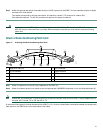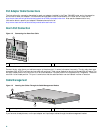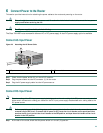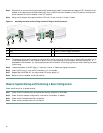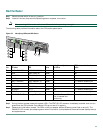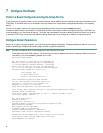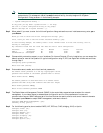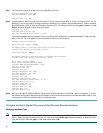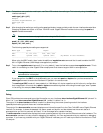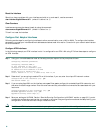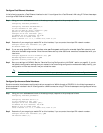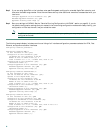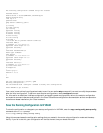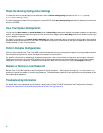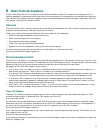
29
Step 1 To be able to use a particular media port, use Cisco IOS to select the media type. This is done by using the media-type
interface command:
media-type { gbic | rj45 }
Example:
interface GigabitEthernet 0/0
media-type rj45
end
Step 2 After changing the media type, configure the speed and duplex to appropriately match the new interface characteristics.
Changing the speed and duplex of a Cisco 7401ASR router Gigabit Ethernet interface is done using the speed and
duplex interface commands.
Note These commands are only applicable when using the RJ-45 media.
speed { 10 | 100 | 1000 | auto }
duplex { full | half | auto }
The following speed/duplex settings are supported:
Media Type Speed Duplex
-------------------------------------------------------
RJ45 10, 100, auto full, half, auto
GBIC ignored (1000) ignored (full) (By default on this interface)
-------------------------------------------------------
When using the GBIC media, there is also the additional negotiation auto command that is used to enable the IEEE
801.1z Gigabit Ethernet (1000 Mbps) autonegotiation protocol.
Step 3 To turn the negotiation auto feature off (it is on by default), issue the interface command no negotiation auto. This is
useful for connecting to other Gigabit Ethernet equipment that does not support 802.1z autonegotiation.
Note The negotiation auto feature is not supported when using the media type rj-45 and will be ignored if
implementation is attempted.
If you change from the GBIC to the rj-45 media type, you must set speed and duplex after you have executed the
media-type command to ensure the interface will operate in the correct mode.
The media-type GBIC mode will always default to 1000-Mbps, full-duplex operation as this is the only configuration
that is supported in this mode. Any speed or duplex commands are ignored while using this media type, even if present
in the config (for example, show running-config).
Debug
Cisco IOS provides two commands to provide information on your interfaces: show interface GigabitEthernet 0/X (where X is
either 0 or 1) and show controllers GigabitEthernet 0/X (where X is either 0 or 1).
The output of the show interface command is useful for determining the current operating mode of the interface
(speed/duplex/media-type) and the current interface statistics.
The output of the show controller command displays more information specific to the Cisco 7401ASR router Gigabit Ethernet
interface. For example, it shows the detected link status, speed, and duplex, and also determines the current status of
autonegotiation and the link partners’ abilities (if it is an autonegotiation-capable interface).
The show controller command also displays the current operating state of the driver and the Ethernet controller hardware. The
show controller command is a very powerful debugging aid, especially for Cisco engineers should you need help in debugging
a problem. If you have any problems with your Gigabit Ethernet interfaces, you will need to provide this information to Cisco
for analysis.



